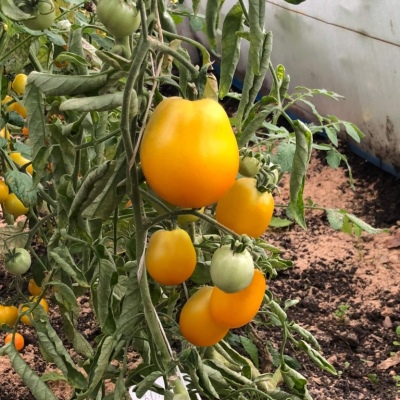
- Authors: Fotev Yu. V., Kotelnikova M. A., Kondakov S. N. (Agrofirma "Altai Seeds" LLC)
- Year of approval: 2010
- Category: grade
- Growth type: determinant
- Appointment: fresh consumption, for pickling and preserving
- Ripening period: early
- Ripening time, days: 110
- Growing conditions: for open ground, for film greenhouses
- Bush size: undersized
- Bush characteristic: compact
Getting a good result in the beds is the eternal dream of any summer residents and gardeners. However, even the best variety, including Patrikeevna tomatoes, has a number of important subtleties and nuances. Therefore, only those who carefully study the characteristics of the plant can achieve success.
Breeding history
Tomato Patrikeevna was created at a time when domestic breeding was reviving after a long decline. The variety was officially registered in 2010. The main development was carried out in the agricultural company "Seeds of Altai". The project was supervised by breeders Fotev, Kondakov and Kotelnikova.
Description of the variety
This tomato in the beds immediately demonstrates the features of determinant development. Patrikeevna is appropriate to grow in an ordinary garden. However, even in a greenhouse under the film, it will show a fairly confident result. Low-growing bushes of this variety are quite compact. Moderately large leaves of a simple green color develop on them.
Farmers and summer residents will be happy to plant such tomatoes:
various localities of the Urals, Siberia, the Volga region and the North Caucasus;
The Far East;
Chernozem region;
center, north and northwest of the European part of Russia.
The main qualities of the fruit
When the patrikeevna berry is just forming and transforming from the ovary, it will have a light green color. Later, as soon as the tomato reaches the necessary ripeness, it will live up to its varietal name due to its yellow color. Other features are as follows:
the berries will be medium in size;
in shape they resemble a pear or a light bulb;
the average weight is 0.095 kg;
the crop will develop from simple inflorescences;
there is a smooth peel on the surface of the berries.
Taste characteristics
The pulp of Patrikeevna is distinguished by an attractive density. It has a comfortable sweet taste. The harvested crop is often consumed fresh. Canning tomatoes is also perfectly acceptable. The plant does not cause any unpleasant taste sensations.
Ripening and fruiting
The variety is usually attributed to the early group. You can wait for the emergence of developed fruits in 110 days (on average) after throwing out the seedlings. At the same time, the weather conditions and the quality of agricultural technology remain extremely important. It is usually possible to remove the fruits in July and August.
Yield
The declared ability to produce up to 5.7 kg (according to other sources - up to 6 kg of berries per 1 sq. M). With this indicator, the tomato turns out to be quite a competitive solution for most vegetable gardens. However, the optimal result is still achieved only with an impeccable approach to work.
The timing of planting seedlings and planting in the ground
Sow seeds in containers or boxes during March. The readiness for transshipment to the final location is achieved in May or June. The specific terms are determined individually each time, because they are influenced by a lot of different factors.

Growing tomato seedlings is an extremely important process, because it largely depends on whether the gardener can harvest at all. All aspects must be taken into account, from seedbed preparation to planting in the ground.
Landing scheme
It is recommended for the cultivation of tomato Patrikeevna to place the wells according to the 400x500 mm system. This information is not from an official supplier, but from a major seller. However, gardeners do not put forward any objections, and therefore it is quite possible to trust her.

Growing and caring
For seeds to germinate, they need a temperature of 22 to 25 degrees. It is necessary to dive the bushes as soon as the first true leaf appears. In greenhouses, plants must be tied up. At the end of the growing season, it is recommended to pinch the top to stop growth. Growing without seedlings is impossible or extremely difficult.
Otherwise, no differences from the cultivation of other early-ripening tomatoes are found. With greenhouse cultivation, it is necessary to ensure that the air is humid, but not excessively - about 60% is enough. A combination of mineral dressing and foliar dressing can invigorate tomatoes if done according to instructions. Pinching is very important, because without it you cannot get an early harvest. The soil needs to be loosened and mulched; protection measures against pests and infections are quite standard.




A plant needs different micronutrients at each stage of growth. All fertilizers can be divided into two groups: mineral and organic. Folk remedies are often used: iodine, yeast, bird droppings, eggshells.
It is important to observe the rate and period of feeding. This also applies to folk remedies and organic fertilizers.



























































































